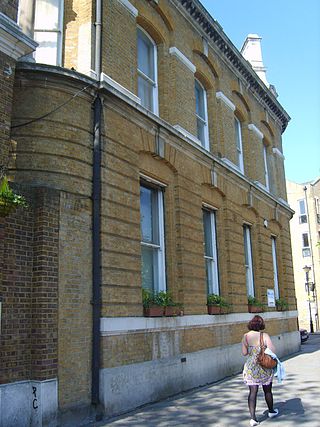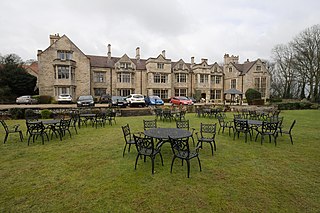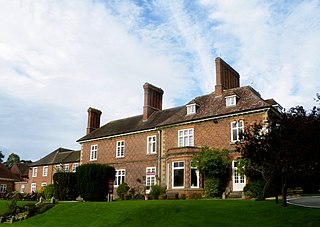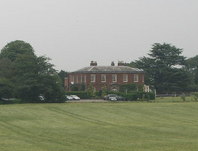
Burton upon Trent, also known as Burton-on-Trent or simply Burton, is a market town in the borough of East Staffordshire in the county of Staffordshire, England, close to the border with Derbyshire. In 2011, it had a population of 72,299. The demonym for residents of the town is Burtonian. Burton is located 11 miles (18 km) south-west of Derby, 27 miles (43 km) north-west of Leicester, 28 miles (45 km) west-south-west of Nottingham and 20 miles (32 km) south of the southern entrance to the Peak District National Park.

William Paget, 1st Baron Paget of Beaudesert, was an English statesman and accountant who held prominent positions in the service of Henry VIII, Edward VI and Mary I.

Bass Brewery was founded in 1777 by William Bass in Burton-upon-Trent, Staffordshire, England. The main brand was Bass Pale Ale, once the highest-selling beer in the UK. By 1877, Bass had become the largest brewery in the world, with an annual output of one million barrels. Its pale ale was exported throughout the British Empire, and the company's iconic red triangle became the UK's first registered trade mark.

Michael Arthur Bass, 1st Baron Burton, KCVO, known as Sir Michael Arthur Bass, 1st Baronet, from 1882 to 1886, was a British brewer, Liberal politician and philanthropist. He sat in the House of Commons from 1865 to 1886 when he was raised to the peerage as Baron Burton.

Charrington Brewery was founded in Bethnal Green, London, in the early 18th century by Robert Westfield. In 1766, John Charrington joined the company, which then traded as Westfield, Moss & Charrington from the Anchor Brewery in Stepney. It merged with United Breweries of London in 1964, and with Bass Brewery in 1967 to become the largest UK brewing company, Bass Charrington. The brewing operations of the company were bought by Interbrew in 2000, while the retail side were renamed Six Continents. In 2003, Six Continents split into a pubs business, now known as Mitchells & Butlers, and a hotels and soft drinks business, now known as InterContinental Hotels Group.

Hamar Alfred Bass was a British brewer, race horse breeder and a Liberal Party politician who sat in the House of Commons from 1878 to 1898.

Redworth Hall is a 17th-century country house at Redworth, Heighington, County Durham, England now converted to a hotel. It is a listed building.
Thomas Levett-Prinsep was an English landowner in Derbyshire and Staffordshire. He took on the additional name of Prinsep on inheriting his uncle's holding of Croxall Hall.

Aston Hall is an 18th-century country house, now converted to residential apartments, at Aston-on-Trent, Derbyshire. It is a Grade II* listed building.

Debden House is a residential adult education college, conference centre and campsite located in Loughton, Essex, England. The house is owned and operated by Newham London Borough Council.

Oakwood Hall, Bingley, West Yorkshire, England is a 19th-century mansion with interior fittings by the Victorian architect William Burges. The hall was constructed in 1864 by Knowles and Wilcox of Bradford for Thomas Garnett, a prosperous textile merchant. The style is "conventionally dour Gothic".

Byrkley Lodge was a country house and later racing horse stud farm, located close to Burton on Trent, Staffordshire. Demolished in 1953, its former grounds are today the site of the St George's Park National Football Centre.

Narborough Hall is a Grade II* listed building in Narborough in Leicestershire. Believed to date from 1596 this Elizabethan manor house was built by James Meade, a local landowner. However it wasn’t until it was extensively remodelled in the mid-19th century that it became known as Narborough Hall. It is notable because of its construction from local pink granite.

Greenham Hall is a country house at Wellington in Somerset. It was once the home of Admiral of the Fleet Sir John Kelly. It is a Grade II listed building.
Edward John Thornewill was an English racehorse owner and, in his youth, a cricketer who played in one first-class cricket match for Cambridge University in 1856. His birthplace is disputed: in one source, he was born at "Newton, Derbyshire", which may also mean Newton Solney; in another, he was born at the family home, Dovecliff Hall, at Stretton, Staffordshire. He died at Algiers, Algeria.
Thornewill and Warham Ltd was a metal hardware and industrial metalwork manufacturer, later an engineering company, based in Burton upon Trent, Staffordshire, England. Under different names it traded from 1740 until 1929, becoming a notable producer of steam engines and railway locomotives. It also constructed two footbridges across the River Trent in Burton.

Albrighton Hall near Shrewsbury, Shropshire, is a house which is Grade II* listed on the National Heritage List for England. It was built in 1630 for the Ireland family and remained in this family for the next five generations until 1804. It was then the home of several notable people until 1953. In the 1990s it was converted into a hotel.

Yeldersley Hall is a building of historical significance in Ashbourne, Derbyshire, England and is listed on the English Heritage Register. It was built in about 1800 by a wealthy landowner and was the residence of many notable people over the next two centuries. Today it is a venue for special events, particularly weddings.

The Old Hall Hotel in Coundon near Coventry, England, is a building of historical significance and is Grade II listed on the English Heritage Register. It was built in about 1800 by a wealthy landowner and was called Coundon Villa and later Coundon Hall. It was the residence of several notable people until about 1947, when it was converted to a hotel. Today it is still a hotel which provides accommodation, restaurant and bar facilities.

West Retford Hotel in Nottinghamshire is a building of historical significance and is Grade II listed on the English Heritage Register. It was built in the 18th century, possibly around 1740, and was the home of many notable people over the next two centuries. Today it is a hotel which provides accommodation, restaurant and bar facilities and caters for special events.






















